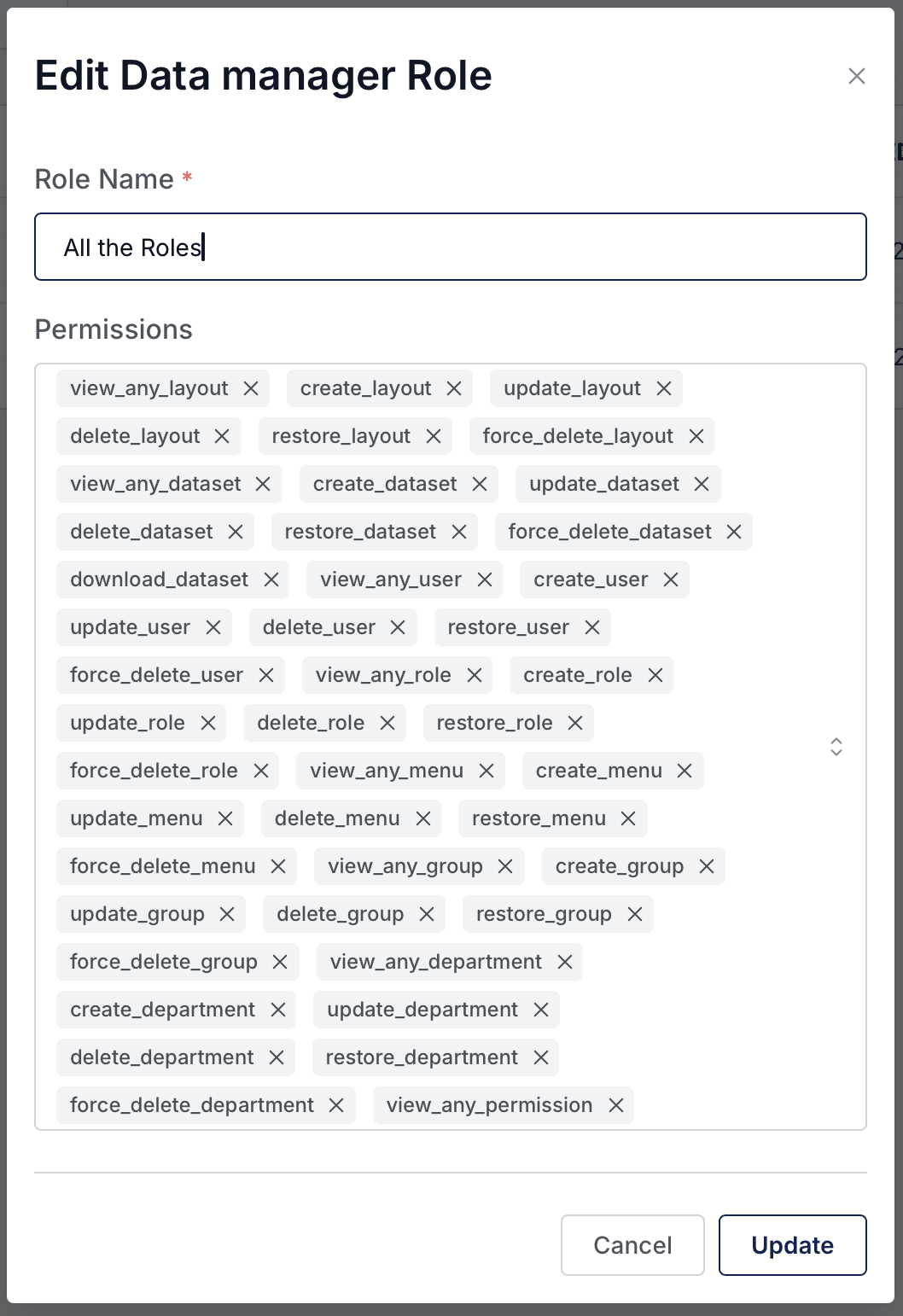
Roles in the Sabasi Dashboard define the permissions assigned to users, determining what actions they can perform within the system. Each role consists of specific permissions grouped into categories for easier management and customization.
How to Assign Roles
- Navigate to the Roles section.
- Select a role or create a new one.
- Use the Edit Role modal to:
- Add or remove permissions.
- Customize permissions based on user or organizational needs.
- Save changes by clicking the Update button.
Grouping of Roles and Permissions
1. Layout Management
These permissions allow users to manage layouts for dashboards.
- view_any_layout: View any layout within the system.
- create_layout: Create new layouts.
- update_layout: Edit or modify existing layouts.
- delete_layout: Delete layouts.
- restore_layout: Restore deleted layouts.
- force_delete_layout: Permanently delete layouts.
2. Dataset Management
These permissions are related to dataset handling, including upload, update, and deletion.
- view_any_dataset: View all datasets in the system.
- create_dataset: Upload new datasets to the platform.
- update_dataset: Edit or update existing datasets.
- delete_dataset: Remove datasets from the platform.
- restore_dataset: Restore previously deleted datasets.
- force_delete_dataset: Permanently delete datasets.
- download_dataset: Download datasets to a local machine.
3. User Management
Permissions for managing users within the organization.
- view_any_user: View details of all users.
- create_user: Add new users to the organization.
- update_user: Edit user details and permissions.
- delete_user: Deactivate or remove users.
- restore_user: Restore previously deleted users.
- force_delete_user: Permanently delete users.
4. Role Management
Permissions related to managing roles within the system.
- view_any_role: View all roles in the organization.
- create_role: Create new roles.
- update_role: Edit existing roles.
- delete_role: Delete roles.
- restore_role: Restore deleted roles.
- force_delete_role: Permanently delete roles.
5. Menu Management
These permissions deal with creating and managing menus.
- view_any_menu: View all menus on the platform.
- create_menu: Create new menus for dashboards.
- update_menu: Edit or modify existing menus.
- delete_menu: Delete menus from the system.
- restore_menu: Restore deleted menus.
- force_delete_menu: Permanently delete menus.
6. Group Management
Permissions for organizing users into groups and managing group settings.
- view_any_group: View all groups within the system.
- create_group: Create new groups.
- update_group: Edit existing group details.
- delete_group: Delete groups from the system.
- restore_group: Restore deleted groups.
- force_delete_group: Permanently delete groups.
7. Department Management
Permissions for managing organizational departments.
- view_any_department: View all departments.
- create_department: Create new departments.
- update_department: Edit department details.
- delete_department: Delete departments.
- restore_department: Restore deleted departments.
- force_delete_department: Permanently delete departments.
8. Permission Management
This permission enables users to view all permissions available in the system.
- view_any_permission: Access a list of all permissions available for roles.
Additional Notes
- Roles can be tailored to organizational needs by combining permissions from multiple categories.
- Changes to a role affect all users assigned to that role.
- Roles can be assigned or edited in the User Management section.
What happens if I delete a role?
If a role is deleted:
- Users assigned to the role will lose their permissions and may experience restricted access until a new role is assigned.
Can I restore a deleted role?
No, deleted roles can be restored